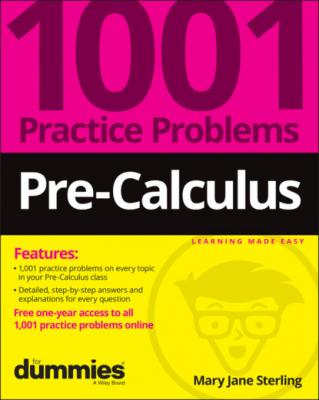Pre-Calculus: 1001 Practice Problems For Dummies (+ Free Online Practice). Mary Jane Sterling
Читать онлайн.| Название | Pre-Calculus: 1001 Practice Problems For Dummies (+ Free Online Practice) |
|---|---|
| Автор произведения | Mary Jane Sterling |
| Жанр | Математика |
| Серия | |
| Издательство | Математика |
| Год выпуска | 0 |
| isbn | 9781119883647 |
Writing Polynomial Expressions When Given Roots and a Point
306–310 Find the lowest-order polynomial that has the listed values as its zeros and whose graph passes through the given point.
306. Zeros: –3, 1, 2
Point:
307. Zeros: –4, –2, 3
Point:
308. Zeros: –3, –2, 1, 2
Point:
309. Zeros:
Point:
310. Zeros: 2 + i, 2 – i, –3, 2
Point:
Graphing Polynomials
311–316 Graph the polynomial by determining the end behavior, finding the x- and y-intercepts, and using test points between the x-intercepts.
311.
312.
313.
314.
315.
316.
Writing Equations from Graphs of Polynomials
317−320 Write an equation for the given polynomial graph.
317.
Illustration by Thomson Digital
318.
Illustration by Thomson Digital
319.
Illustration by Thomson Digital
320.
Illustration by Thomson Digital
Chapter 6
Exponential and Logarithmic Functions
Exponential and logarithmic functions go together. You wouldn’t think so at first glance, because exponential functions can look like
Exponential and logarithmic functions can have bases that are any positive number except the number 1. The special cases are those with base 10 (common logarithms) and base e (natural logarithms), which go along with their exponential counterparts.
The whole point of these functions is to tell you how large something is when you use a particular exponent or how big of an exponent you need in order to create a particular number. These functions are heavily used in the sciences and finance, so studying them here can pay off big time in later studies.
The Problems You’ll Work On
In this chapter, you’ll work with exponential and logarithmic functions in the following ways:
Evaluating exponential and log functions using the function rule
Simplifying expressions involving exponential and log functions
Solving exponential equations using rules involving exponents
Solving logarithmic equations using laws of logarithms
Graphing exponential and logarithmic functions for a better view of their powers
Applying exponential and logarithmic functions to real-life situations
What to Watch Out For
Don’t let common mistakes trip you up. Here are some of the challenges you’ll face when working with exponential and logarithmic functions:
Using the rules for exponents in various operations correctly
Applying the laws of logarithms to denominators of fractions
Remembering the order of operations when simplifying exponential and log expressions
Checking for extraneous roots when solving logarithmic equations
Understanding Function Notation
321–325 Evaluate the function at the indicated points.
321. Evaluate the function
322. Evaluate the function
323. Evaluate the function
324.
